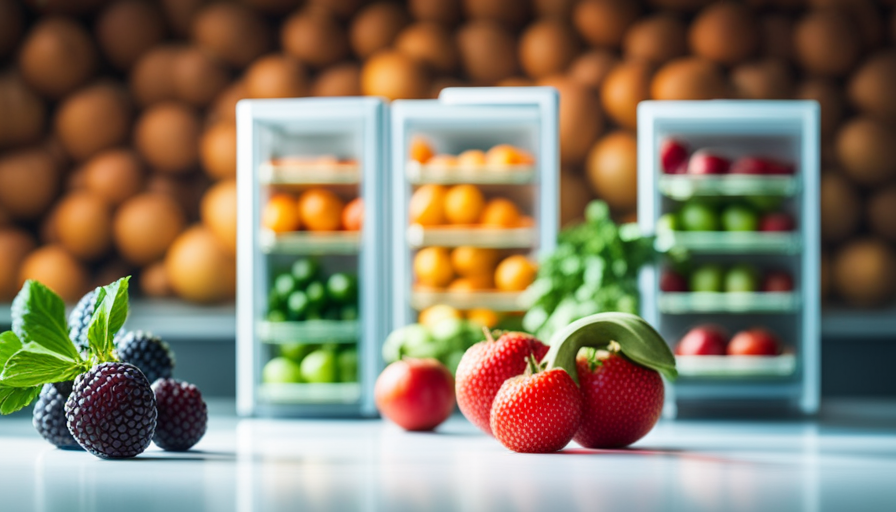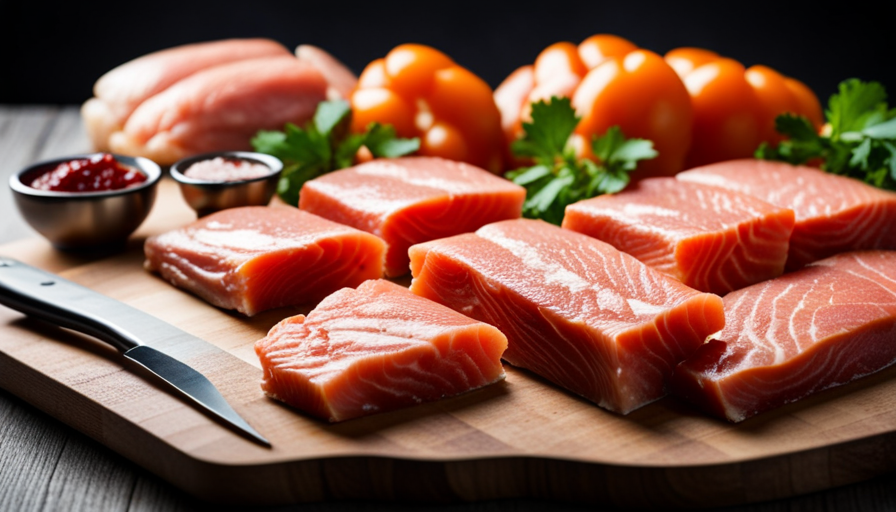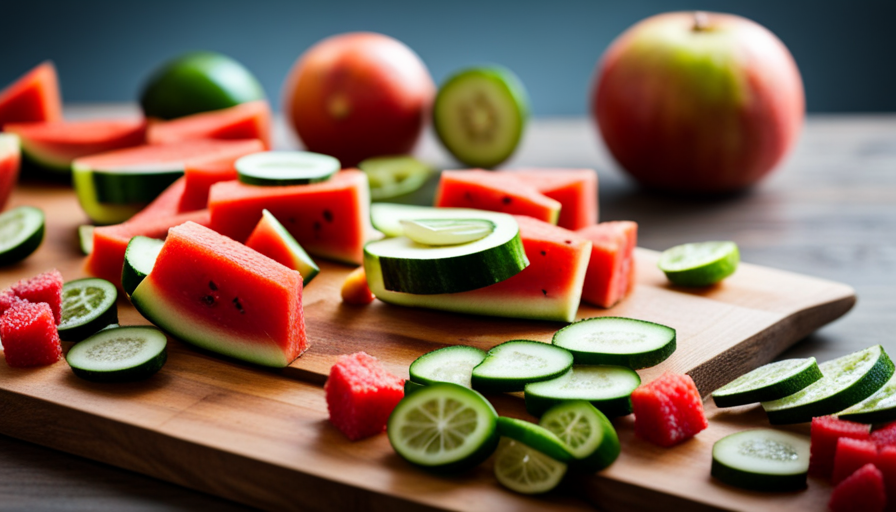Have you ever found yourself unsure if your meal is fully cooked or still raw? Fret not, my fellow food lovers! In this article, I will share my top tips and techniques for figuring out if your food is undercooked or just right.
By observing the texture, color, temperature, and even the smell of your culinary creations, you can become a true culinary connoisseur. Whether you’re cooking meat, seafood, pasta, rice, or any other delectable dish, I’ve got you covered.
I’ll even teach you how to use a thermometer to ensure your meat and seafood are cooked to perfection. So grab your apron and get ready to embark on a culinary adventure like never before. Let’s dive into the world of food and discover the secrets to distinguishing between raw and cooked with finesse and flair!
Key Takeaways
- Texture is a key indicator: raw food is crunchier, while cooked food is softer and tender.
- Color can also provide clues: raw food tends to be vibrant, while cooked food is more muted and uniform.
- Use a thermometer to check the temperature of food, especially for meat and seafood, to ensure proper cooking temperature.
- Sensory evaluation, including smell and taste, is important in determining if food is raw or cooked. Cooked food tends to develop richer and more complex flavors, while raw food often has a fresh, crisp taste.
Observe the Texture and Color
Take a close look at the texture and color of the food to determine if it’s been cooked or if it’s still raw. One way to do this is through a taste test. If the food has a raw taste, it’s likely still uncooked. On the other hand, if it has a cooked flavor, it’s safe to assume that it’s been cooked properly.
Texture analysis is another important factor to consider. Raw food tends to have a crunchier texture, while cooked food is usually softer and more tender. For example, raw vegetables have a crisp texture, while cooked vegetables become softer and easier to chew. Similarly, raw meat is tough and chewy, but when cooked, it becomes more tender and juicy.
Color can also provide clues about the food’s cooking status. Raw food often has a vibrant and natural color, while cooked food tends to take on a more muted and uniform appearance. For instance, raw chicken has a pinkish hue, while cooked chicken turns white.
By observing the texture and color of the food, you can determine whether it’s raw or cooked. However, to further confirm its cooking status, it’s essential to check the temperature.
Check the Temperature
Using a food thermometer is essential for ensuring the safety of your meals, as studies have shown that undercooked food can lead to severe cases of food poisoning. Here are three ways you can check the temperature of your food to determine if it’s raw or cooked:
-
Check for steam: When food’s raw, it usually produces steam as it cooks. By observing the presence of steam, you can determine if the food’s still cooking or if it’s reached the desired temperature.
-
Feel the texture: Raw food tends to have a softer and more raw texture, while cooked food’s usually firmer and cooked through. By gently pressing the food with your finger or a utensil, you can feel the texture and determine if it’s raw or cooked.
-
Use a food thermometer: This is the most accurate way to check the temperature of your food. Insert the thermometer into the thickest part of the food and wait for the reading. Different types of food have different recommended internal temperatures, so make sure to consult a reliable source for the specific temperatures.
By checking the temperature using these methods, you can ensure that your food’s cooked thoroughly and safe to eat. Look for signs of browning or crisping to determine if it’s fully cooked.
Look for Signs of Browning or Crisping
When you see those delicious golden brown edges and hear the satisfying sound of a crispy crust, you know your meal is perfectly cooked and ready to be enjoyed. Browning indicators in baked goods are a clear sign that they’ve been cooked to perfection.
Whether it’s a loaf of bread, cookies, or a pie, the browning of the outer surface indicates that the heat’s penetrated the dough, creating a desirable texture and flavor.
Similarly, when it comes to fried foods, you can rely on the signs of crisping to determine their doneness. As foods are submerged in hot oil, they undergo a transformation that results in a crispy exterior. The process of frying causes moisture to evaporate, leaving behind a crunchy coating that’s a telltale sign of cooked food.
These browning indicators and crisping signs serve as visual cues that the food’s been properly cooked. However, it’s important to note that they may not always be accurate indicators of doneness for all types of food.
For meats and seafood, it’s essential to use a thermometer to ensure they’ve reached the appropriate internal temperature. This will be discussed in the subsequent section about using a thermometer for meat and seafood.
Use a Thermometer for Meat and Seafood
To ensure that your meat and seafood are cooked to perfection, it’s crucial that you utilize a thermometer. Using a food thermometer is the most accurate way to determine if your food is raw or cooked. Here are some reasons why using a thermometer is important:
-
Accuracy: A food thermometer provides precise readings, ensuring that your meat and seafood reach the appropriate internal temperature for safe consumption.
-
Safety: Undercooked meat and seafood can contain harmful bacteria that can cause foodborne illnesses. A thermometer helps you avoid this risk by ensuring that your food is cooked thoroughly.
-
Consistency: By using a thermometer, you can consistently achieve the desired level of doneness for your meat and seafood.
-
Avoid Overcooking: Overcooking can result in dry and tough meat or seafood. A thermometer allows you to cook your food just enough, preventing it from becoming overcooked.
-
Different Cooking Methods: Different cooking methods require different internal temperatures. With a thermometer, you can easily adapt to various cooking techniques.
Understanding the cooking process and using a food thermometer go hand in hand when it comes to achieving perfectly cooked meat and seafood. By accurately monitoring the internal temperature, you can ensure that your food is cooked to the right level of doneness.
Now, let’s move on to the next section and explore the importance of paying attention to cooking instructions.
Pay Attention to Cooking Instructions
Make sure you pay attention to the cooking instructions, buddy, so you don’t end up with a disappointing meal. Following cooking instructions is crucial to ensure that your food is cooked properly and safe to eat. It not only helps you achieve the desired taste and texture but also prevents common mistakes that can ruin your dish.
To emphasize the significance of following cooking instructions, let’s take a look at this table:
| Importance of Following Cooking Instructions | Common Mistakes to Avoid |
|---|---|
| Ensures food is cooked thoroughly | Overcooking |
| Prevents foodborne illnesses | Undercooking |
| Preserves the nutritional value of the food | Ignoring resting time |
By referring to the cooking instructions, you can avoid overcooking, which leads to dry and tough meat or undercooking, which poses a risk of foodborne illnesses. Additionally, following the instructions ensures that the food retains its nutritional value and allows for proper resting time, which enhances the flavors.
Now that we understand the importance of cooking instructions, let’s move on to the next section about using visual clues for eggs and vegetables.
Use Visual Clues for Eggs and Vegetables
Keep an eye out for visual clues when cooking eggs and vegetables, so you can achieve that perfect, mouthwatering texture. Visual cues for determining doneness of eggs and vegetables are essential for ensuring that they’re cooked to the right level.
When it comes to eggs, you can visually determine their cooking level by observing the appearance of the egg whites and yolks. For a soft-boiled egg, the whites should be set but still slightly runny, while the yolk should be thick but not completely solid. For a hard-boiled egg, both the whites and yolks should be fully set.
Vegetables, on the other hand, can be visually assessed by their color and texture. Tender-crisp vegetables, like asparagus or broccoli, should be vibrant in color and have a slight crunch when bitten into. Cooked vegetables, such as carrots or potatoes, should be soft and easily pierced with a fork.
By using these visual cues, you can ensure that your eggs and vegetables are cooked to perfection.
Now, let’s move on to the next section and learn how to test the firmness of pasta and rice.
Test the Firmness for Pasta and Rice
After using visual clues to determine the doneness of eggs and vegetables, it’s now time to move on to testing the firmness of pasta and rice.
When it comes to these starchy staples, texture is key. To check if pasta is cooked, I like to take a small piece and taste it. It should be tender but still have a slight bite to it, known as ‘al dente.’ If it feels too soft or mushy, it needs more cooking time.
For rice, I gently press a grain between my fingers. It should be firm but not hard, with a slight resistance. If it’s too hard, it needs more cooking, and if it’s too soft, it’s overcooked.
Testing the texture and taste of pasta and rice is crucial to ensure they are cooked properly. Once you’re confident that the texture is just right, you can move on to considering the smell of the dish. This is another important aspect in determining if the food is raw or cooked, as the aroma can provide valuable insight into its doneness.
Consider the Smell
Once you’re confident the pasta and rice have reached the desired texture, it’s time to follow your nose and let the aromatic scents guide you in determining their doneness.
Smell is a powerful indicator of whether the food is raw or cooked. When pasta or rice is cooked, it releases a pleasant and inviting aroma that fills the kitchen. The scent of cooked pasta is reminiscent of freshly baked bread, while cooked rice emits a nutty and slightly sweet fragrance. These smells indicate that the starches in the pasta and rice have been fully gelatinized and are ready to be enjoyed.
On the other hand, detecting freshness and identifying spoilage is equally important when it comes to determining if the food is raw or cooked. If the pasta or rice has a foul or rancid odor, it is a clear sign that it has gone bad and should not be consumed. Spoiled pasta and rice can have a musty, sour, or even moldy smell, which is indicative of bacterial growth or contamination.
Now that you’ve determined the doneness of your pasta or rice using your sense of smell, it’s time to move on to the next step of checking for tenderness using a knife or fork.
Use a Knife or Fork to Check for Tenderness
To determine if your pasta or rice is tender enough, simply take a knife or fork and gently pierce a few grains or strands. Using a fork or knife to determine food tenderness has several benefits.
Here’s how you can use these tools to check if your food is raw or cooked:
-
Resistance: When you pierce the food with a knife or fork, you’ll feel resistance if it’s not cooked properly. Raw food will be harder to penetrate, while cooked food should offer less resistance.
-
Texture: As you pierce the food, pay attention to its texture. Raw food tends to be firm and tough, while cooked food should be soft and tender.
-
Appearance: By using a knife or fork, you can observe the appearance of the food. Raw food may have a more opaque or translucent appearance, while cooked food should appear more translucent or opaque.
-
Ease of cutting: Once you’ve pierced the food, try cutting it with the knife or fork. Raw food will be difficult to cut through, while cooked food should easily separate into smaller pieces.
By using a knife or fork to check food tenderness, you can ensure that your dish is cooked to perfection. Now, let’s move on to the next step and trust our taste buds to confirm the flavor.
Trust Your Taste Buds
Let your taste buds be your guide in discovering the true flavor of your dish. When it comes to determining whether food is raw or cooked, sensory evaluation is key. Our taste buds play a crucial role in flavor perception, allowing us to distinguish between different tastes and textures.
When assessing the doneness of food, pay attention to the flavors that come through. Raw food often has a fresh, crisp taste, while cooked food tends to develop richer and more complex flavors. For example, a raw carrot will have a distinct crunch and a slightly sweet taste, while a cooked carrot will be softer and have a sweeter, more intense flavor.
When tasting food, take note of any changes in texture as well. Raw food generally has a firmer, more fibrous texture, while cooked food becomes tender and easier to chew. For instance, a raw piece of chicken will be tough and chewy, whereas a cooked piece will be juicy and tender.
By trusting your taste buds and paying attention to the sensory evaluation, you can confidently determine whether your food is raw or cooked. Remember, practice makes perfect, so keep experimenting and refining your palate to become a true culinary connoisseur.
Frequently Asked Questions
Can I determine if food is raw or cooked just by looking at it?
Just by looking at food, it’s difficult to determine if it’s raw or cooked. However, there are some visual cues that can help determine the doneness of meat. For example, cooked meat will often have a brown or golden color, while raw meat tends to be pink or red. Additionally, texture plays a role in identifying the cooking status of food. Cooked meat will be tender and easy to cut, while raw meat will be tougher and harder to slice.
What temperature range indicates that meat is cooked?
The temperature range that indicates meat is cooked is typically between 145°F (63°C) for medium rare and 165°F (74°C) for well done. It’s important to use a meat thermometer to ensure the meat reaches the proper internal temperature.
When it comes to eggs, a cooked egg will have a solid white and a firm yolk, while a raw egg will have a runny yolk and translucent whites.
How can I tell if eggs are raw or cooked?
To determine if eggs are boiled or raw without cracking them, there are a few methods you can try.
Firstly, you can spin the egg on a flat surface. A cooked egg will spin smoothly, while a raw egg will wobble.
Secondly, gently shake the egg near your ear. If you hear a sloshing sound, it’s raw, but if it’s silent, it’s boiled.
Lastly, you can use the water test by placing the egg in a bowl of water. A raw egg will sink, while a boiled egg will float.
Are there any visual clues that can help me determine if vegetables are raw or cooked?
When determining if vegetables are raw or cooked, visual cues and texture analysis can be helpful.
Visual cues include looking for vibrant colors and crispness in raw vegetables, while cooked vegetables may appear softer and more muted in color.
Texture analysis involves feeling the firmness of the vegetable. Raw vegetables tend to be firmer, while cooked vegetables are often softer.
These indicators can provide valuable clues in determining whether vegetables are raw or cooked.
How can I use my sense of smell to determine if food is raw or cooked?
Using my sense of smell is a valuable tool in determining if food is raw or cooked. One might argue that visual cues are sufficient, but smell adds an extra layer of assurance.
When food is raw, it has a fresh, natural scent. However, once cooked, the aroma changes, becoming richer and more developed. This is especially important when it comes to meat, as proper cooking temperatures ensure safety and kill harmful bacteria.
Is Eating Raw Food Dangerous and How Can I Tell If Food Is Raw or Cooked?
Eating raw food signs are important to recognize to prevent foodborne illness. Look for indicators such as cold and uncooked texture, strong natural flavors, and distinct crunchy or watery qualities. When in doubt, use a food thermometer to ensure that your food reaches the appropriate internal temperature for safety.
Conclusion
Well, folks, after going through all these steps, you should now be a pro at determining whether your food’s raw or cooked. Remember, it’s all about the texture, color, temperature, browning, and crispiness.
Don’t forget to use a thermometer for meat and seafood ’cause we all know the importance of food safety. And of course, follow those cooking instructions like your life depends on it.
So, next time you’re in doubt, just trust your senses, use that knife or fork, and let your taste buds be the ultimate judge.
Happy cooking, my friends!










